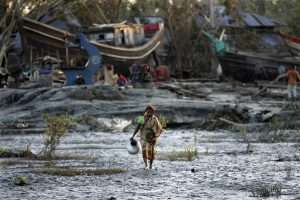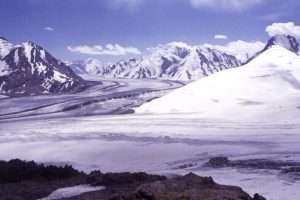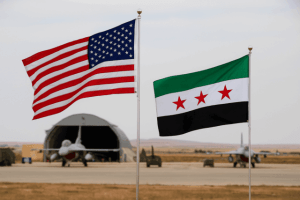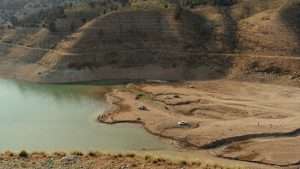Iran’s President warns Tehran of evacuation as drought worsens

This image shows the low level of water in the Latyan Dam that provides water to Tehran [Getty]
Iran’s President Masoud Pezeshkian has warned that Tehran may soon face water rationing and, in the worst case, evacuation as the country’s capital struggles through one of the most severe water crises in its history, reported AP News and other agencies on November 7.
“If it doesn’t rain in Tehran by late November, we’ll have to ration water. And if it still doesn’t rain, we’ll have to evacuate Tehran,” Pezeshkian said, according to The New Arab.
The president described the situation as “extremely critical,” warning that the city’s main water reservoirs are at their lowest levels in six decades.
Tehran’s five main dams including Latyan, Taleqan, Karaj, Lar and Mamloo have all seen severe drops in capacity. In the east of the city, the Latyan Dam is only about nine percent full.
“Latyan’s water storage is just nine million cubic meters,” Deputy Energy Minister Mohammad Javanbakht told AP News, calling the situation “critical”.
Tehran, home to around nine million people and roughly 14.5 million in its greater province, is entering its sixth consecutive year of drought. Average rainfall in the region has dropped by nearly half compared to the long term average, leaving rivers and reservoirs parched.
The shortage has also impacted Iran’s electricity generation, which relies heavily on hydropower and thermal plants that depend on water for cooling. Several power plants have already been forced offline as water levels in rivers and reservoirs hit record lows.
Experts have long warned that Iran’s water crisis stems not only from climate conditions but also decades of policy missteps. Agriculture accounts for nearly 80 percent of the country’s freshwater use, yet inefficient irrigation and cultivation of water intensive crops in arid areas have drained key resources. Over extraction of groundwater has led to widespread land subsidence, while diversion of rivers to industrial zones has further reduced available supplies for major cities.
In addition, rapid urban growth has overwhelmed Tehran’s infrastructure. The city’s population has more than doubled since the 1980s, but water management and renewable energy investment have lagged far behind.
Environmental experts have urged the government to modernise irrigation systems, invest in desalination and recycling plants, and improve efficiency in both industry and agriculture.
Government agencies are reportedly drafting emergency plans for rationing and distribution if the dry conditions persist through winter. Some reservoirs are estimated to hold only enough water to sustain the city for several weeks.
Without substantial rainfall in the coming weeks, Iran’s capital could soon face evacuation – one of the most drastic measures ever considered for a major urban centre.
AP News, The New Aran and Maghrebi.org
Want to chase the pulse of North Africa?
Subscribe to receive our FREE weekly PDF magazine












